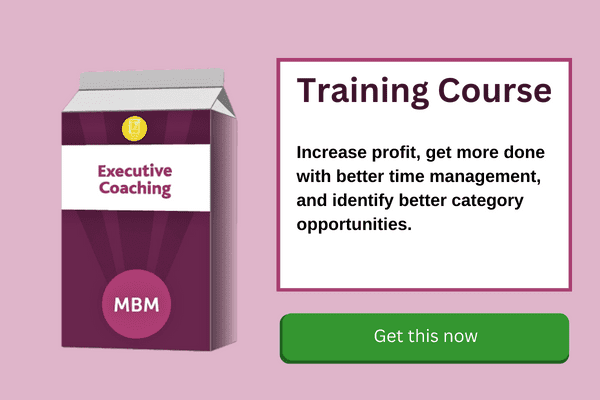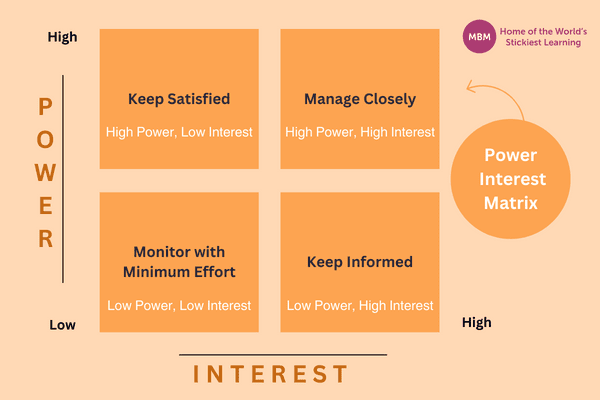Try This Useful Tool for Strategic Stakeholder Insights
In the ever-evolving landscape of business, successful management isn’t solely about products, profits, and processes. It hinges on the relationships a company cultivates and maintains with its stakeholders. These stakeholders, ranging from customers and employees to investors and regulators, have a profound impact on a business’s success, often holding the power to influence decisions and outcomes. Understanding and effectively managing these stakeholders is a strategic imperative. This is where the Power-Interest Matrix comes into play. It’s a dynamic tool that helps businesses map and comprehend the intricate web of stakeholders’ interests and influence, providing a roadmap for tailored engagement.
In this article, we delve into the fascinating world of the Power-Interest Matrix, exploring its significance, its various applications, and the strategies that can turn stakeholder management from a potential headache into a strategic asset for your business. Whether you’re a seasoned executive or a budding entrepreneur, the insights you gain here will undoubtedly enhance your ability to navigate the complex world of stakeholder dynamics.

Understanding Stakeholder Dynamics
In the corporate world, stakeholder management is a pivotal skill, but it’s often a misunderstood or overlooked aspect of business strategy. Stakeholders are individuals or groups who can significantly affect or are affected by your business activities. These encompass a wide spectrum, from customers and employees to suppliers, investors, governmental bodies, and even the local community. What makes stakeholder management intricate is the unique blend of power and interest each of these entities holds. This is where the Power-Interest Matrix shines as an invaluable tool.
Decoding the Power-Interest Matrix
The Power-Interest Matrix, also known as the Influence-Interest Grid, is a visual framework designed to help businesses analyse and categorise their stakeholders based on two primary attributes: their level of power and their level of interest.
- Power, in this context, refers to the ability of a stakeholder to impact your business’s decisions or activities.
- Interest pertains to how invested or concerned a stakeholder is in what your business does.
By plotting stakeholders on a graph using these two dimensions, you can pinpoint where they fall on the matrix, which then guides your approach to managing and engaging with them. This matrix isn’t just a static tool; it evolves as your business relationships and activities change, allowing for dynamic stakeholder analysis.

The Four Quadrants
The Power-Interest Matrix classifies stakeholders into four distinct quadrants, each of which demands a specific approach:
Sticky Learning ® is 7 times more effective than 1-day training courses. Plus, you will get a Chain of Evidence proving your Return on Investment. Discover soft skills training that changes behaviours long term.

1- High Power, High Interest:
These stakeholders are often the most critical, as they possess the power to impact your business significantly and are highly interested in what you do. Engaging them closely is imperative.
2- High Power, Low Interest:
These stakeholders have substantial influence but aren’t necessarily invested in your day-to-day activities. Effective communication and occasional engagement are key.
3- Low Power, High Interest:
Stakeholders in this category are genuinely interested but don’t have much influence. Keeping them informed and involved can help you gain support or avoid potential issues.
4- Low Power, Low Interest:
These stakeholders have minimal impact and minimal interest. While you should still maintain open lines of communication, your interactions may be less frequent.
Why It Matters in Business
In the fast-paced and interconnected world of business, understanding where each stakeholder fits on the Power-Interest Matrix can be a game-changer. It allows you to tailor your strategies, allocate resources wisely, and ensure that you’re giving the right amount of attention to the right people or groups.
Failing to grasp the nuances of stakeholder dynamics can lead to missed opportunities, unforeseen challenges, and potential reputation damage. In the following sections, we’ll dive deeper into each quadrant and explore the strategies that can help you effectively manage and engage with stakeholders in every category.
So whether you’re launching a startup, managing a corporate empire, or working in a non-profit organisation, the Power-Interest Matrix is a versatile tool that can significantly enhance your business acumen.
Identifying Key Stakeholders: The Foundation of Effective Stakeholder Management

In the complex world of business, identifying key stakeholders is akin to finding the cornerstone of a successful strategy. These are the individuals or groups that wield substantial power and hold a high degree of interest in your business endeavours, as illustrated by the power interest matrix.
Recognising and engaging with them effectively can be the difference between a thriving operation and one beset by challenges. But how do you identify these vital stakeholders?
1. Mapping Your Stakeholder Landscape
The first step in identifying key stakeholders is to map your stakeholder landscape comprehensively, often utilising tools such as the power interest matrix. This involves creating a comprehensive list of all the individuals or groups that can impact or are affected by your business.
From customers and employees to suppliers, investors, regulators, and even competitors, the list can be extensive. Consider both direct and indirect stakeholders. Once you have this expansive list, you’ll begin to see the diverse web of relationships your business maintains.
2. Analysing Power and Interest
With your stakeholder list in hand, it’s time to analyse each entity’s level of power and interest. Power refers to their capacity to influence your decisions, while interest represents their level of concern or involvement in your activities. Stakeholders with high power and high interest typically hold the most significance.
These are the key stakeholders whose actions can significantly impact your business, and understanding their expectations and motivations is crucial. On the other hand, those with low power and low interest may require minimal attention. The Power-Interest Matrix is an effective tool to help you visualise and categorise these stakeholders.
3. Listening and Dialogue
While quantitative analysis is essential, don’t underestimate the value of qualitative insights. Engage in open dialogue with your stakeholders, even if they fall in the low-power or low-interest categories. Their perspectives can evolve, and building positive relationships with them can lead to unexpected opportunities or support. For high-power, high-interest stakeholders, regular and direct communication is key to aligning your strategies with their expectations.
4. Continual Monitoring
Stakeholder identification is not a one-and-done task. It’s an ongoing process that requires continual monitoring and adjustment. The business landscape is dynamic, and stakeholders can shift from one category to another as their interests and influence change. Regularly reviewing your stakeholder landscape and Power-Interest Matrix will help you adapt your engagement strategies as needed, ensuring that you’re always aligned with the most critical stakeholders.
Attention: Subscribe through LinkedIn to know when we publish a new article.
Strategies for Managing High-Power, Low-Interest Stakeholders
In the realm of stakeholder management, perhaps one of the more challenging scenarios you can encounter is dealing with stakeholders who wield substantial power but exhibit low interest in your business or project.
This quadrant of the Power-Interest Matrix represents individuals or groups who can significantly impact your operations but might not be actively engaged. Managing these stakeholders effectively requires a nuanced approach that acknowledges their power while respecting their limited interests.
1. Efficient Communication
For stakeholders with high power and low interest, often positioned in the upper-left quadrant of the power interest matrix, it’s essential to adopt a communication strategy that is both efficient and concise. These stakeholders don’t have the patience or inclination for lengthy reports or extensive updates.
Instead, provide them with periodic, high-level summaries that focus on the key points. Clearly articulate the impact of their involvement, particularly regarding how it can influence the aspects they are genuinely concerned about. This approach respects their limited bandwidth while ensuring that they remain informed about issues crucial to them.
2. Customised Engagement
Since stakeholders with high power and low interest, as indicated by the power interest matrix, might not be inclined to actively participate, it’s essential to tailor your engagement efforts to suit their preferences. This could involve offering them one-on-one discussions or periodic briefings rather than involving them in lengthy group meetings.
By customising your approach, you demonstrate that you respect their time and that their input is valued, which can lead to more effective collaboration and support from these key stakeholders.
3. Issue-Specific Engagement
High-power, low-interest stakeholders are most likely to engage when the issue directly affects their interests or has a significant impact on their areas of concern. Identify the topics or decisions that intersect with their spheres of influence and focus your engagement efforts accordingly. By demonstrating that you recognise their power and expertise in specific areas, you are more likely to elicit their participation when it matters most.
4. Leverage Their Authority
One powerful strategy for managing high-power, low-interest stakeholders is to leverage their authority for your benefit. While they may not be highly engaged in every aspect of your business, they can be influential allies when it comes to gaining support or approvals.
Work strategically with them, highlighting the areas where their input and endorsement can be most valuable. By doing so, you not only manage their power effectively but also foster a mutually beneficial relationship.
Engaging High-Power, High-Interest Stakeholders: The Art of Collaboration

In the intricate dance of stakeholder management, one of the most crucial and potentially rewarding categories on the Power-Interest Matrix is the high-power, high-interest quadrant.
Stakeholders in this quadrant possess both the ability to significantly influence your business and a genuine passion for its success. Nurturing strong, collaborative relationships with these stakeholders can lead to synergistic partnerships and fruitful outcomes.
Here, we explore strategies to effectively engage and collaborate with high-power, high-interest stakeholders:
1. Open and Transparent Communication
The cornerstone of managing high-power, high-interest stakeholders is open and transparent communication. These stakeholders are often well-versed in your industry and business operations, so they value being kept in the loop.
Provide them with comprehensive, timely information on your activities, goals, challenges, and successes. Ensure that they are aware of potential impacts on their interests. Regular updates and open channels of communication allow you to harness their expertise and insights.
2. Collaborative Decision-Making
Incorporate high-power, high-interest stakeholders into your decision-making processes. Seek their input and engage them in discussions related to strategic choices or significant changes. By involving them in the decision-making, you demonstrate that their perspectives are genuinely valued. This collaborative approach not only leverages their expertise but also helps align your strategies with their interests.
3. Address Their Concerns
High-power, high-interest stakeholders often have specific concerns or priorities that matter deeply to them. Take the time to understand these concerns and proactively address them in your business strategies. Whether it’s environmental sustainability, ethical considerations, or financial stability, tailoring your approach to meet their key concerns can fortify your relationship and yield positive outcomes.
4. Show Appreciation and Recognition
Appreciation goes a long way in stakeholder management. Above all, high-power, high-interest stakeholders invest their time and resources in your business, and they expect recognition for their contributions. Acknowledge their involvement, and celebrate their achievements. Additionally, by demonstrating your appreciation, you reinforce the sense of partnership and collaboration, fostering a more robust and enduring relationship.
After all, stakeholders play a critical role in your business’s success. If you value their contributions, you’re more likely to retain their support. Afterwards, you can count on their continued engagement, and after that, they may become even more dedicated to your cause.
Dealing with Low-Power, High-Interest Stakeholders: Nurturing Informed Advocates
These individuals or groups may not possess significant influence, but they are genuinely interested in your business and its activities. While they might not be able to shape decisions directly, their advocacy and support can be invaluable.
In this section, we explore strategies for effectively dealing with low-power, high-interest stakeholders:
1. Engage in Active Listening
Low-power, high-interest stakeholders, albeit they may lack direct influence, often have a deep passion for your industry or cause. Additionally, they can provide unique insights and, all of a sudden, offer valuable feedback that can significantly benefit your business. As a result, they can act as powerful advocates for your cause.
Because showing that you value their perspectives can have a significant impact, you should make it a priority. Moreover, when you engage with low-power, high-interest stakeholders, it’s not only about tapping into their passion but also about acknowledging their role in your organisation’s success.
2. Educate and Inform
Low-power, high-interest stakeholders may not have all the information they need to advocate effectively. Accordingly, it’s essential to take the initiative and educate them about your business. Above all, providing them with insights into industry trends and the impact of your work can make a significant difference.
Additionally, it’s crucial to remember that while these stakeholders may have a strong passion for your cause, they might not possess all the necessary knowledge to represent your business effectively. After all, being well-informed is a key factor in advocacy. If they lack the information they need, their ability to advocate effectively can be limited.
3. Foster Collaboration
Collaboration is a powerful strategy for dealing with low-power, high-interest stakeholders. Encourage them to participate in projects or initiatives that align with their interests. Their active involvement not only benefits your business but also allows them to experience the direct impact of their support. Collaborative efforts can transform them into motivated advocates who champion your cause.
4. Recognise and Reward Their Advocacy
Appreciation goes a long way in cultivating the support of low-power, high-interest stakeholders. Acknowledge and reward their advocacy efforts. This recognition can take various forms, from public acknowledgement to small tokens of appreciation. By celebrating their commitment, you encourage them to continue advocating on your behalf.
Strategies for Low-Power, Low-Interest Stakeholders: Minimal Effort, Maximum Impact

These individuals or groups, often positioned in the lower-left quadrant of the power interest matrix, have limited influence over your business and often display only a passing interest in your activities.
While it may be tempting to allocate minimal resources to them, their support can still prove beneficial. In this section, we explore strategies for effectively managing low-power, low-interest stakeholders, recognising that even though their impact may be limited, their engagement can contribute to the overall success of your endeavours.
1. Maintain Open Channels of Communication
Even with low-power, low-interest stakeholders, as identified on the power interest matrix, maintaining open channels of communication is essential. Regular updates, newsletters, or periodic check-ins can help keep them informed about your business without overwhelming them with excessive information. While they may not actively engage, this passive communication ensures they remain aware of your activities, which can be valuable in certain situations.
2. Offer Minimal Engagement Opportunities
For this quadrant of stakeholders, offering minimal but inclusive engagement opportunities can be a valuable strategy. This might include occasional surveys or feedback requests. While they may not actively participate, giving them a voice can help you gather insights and ensure they feel included and considered, which may come in handy when their interests align more closely with your activities.
3. Be Responsive and Respectful
Respect and responsiveness are key when dealing with low-power, low-interest stakeholders. While they may not be engaged today, circumstances can change. Maintaining a respectful and responsive approach ensures that they are more likely to reach out or become involved when their interests or influence evolve. Being dismissive of this quadrant can lead to missed opportunities and potential reputation damage.
Practical Applications of the Power-Interest Matrix: Making Informed Decisions

The Power-Interest Matrix is not just a theoretical concept; it’s a versatile tool with numerous practical applications that can significantly benefit your business. By utilising this matrix, you can make more informed decisions, allocate resources efficiently, and tailor your engagement strategies for each stakeholder.
Here, we delve into some practical applications of the Power-Interest Matrix in the real world of business:
1. Resource Allocation and Prioritisation
One of the primary applications of the Power-Interest Matrix is in resource allocation. By categorising stakeholders based on their power and interests, you can determine where to focus your efforts and resources.
High-power, high-interest stakeholders are the top priority, as their actions can significantly impact your business. In contrast, low-power, low-interest stakeholders may require minimal attention.
This approach ensures you’re not expending unnecessary resources on stakeholders who have limited influence or interest.
2. Tailored Engagement Strategies
The Power-Interest Matrix is a valuable tool for developing tailored engagement strategies. Stakeholders in different quadrants require unique approaches.
For high-power, high-interest stakeholders, a collaborative and transparent engagement strategy is vital. Low-power, high-interest stakeholders may benefit from informative updates and opportunities for collaboration.
By customising your engagement, you can effectively manage relationships and ensure that you’re meeting the specific needs of each stakeholder group.
3. Risk Management and Issue Mitigation
Identifying stakeholders in the Power-Interest Matrix helps in assessing potential risks and mitigating issues. By understanding who has the power to impact your operations and who holds a high level of interest, you can anticipate challenges and develop proactive risk management plans.
High-power, low-interest stakeholders may pose specific risks that need to be addressed strategically. By being prepared and informed, you can better navigate potential roadblocks and maintain a positive business environment.
Conclusion and Takeaways
Stakeholder management is not just a box to be checked; it’s a dynamic strategy that can shape the course of your success. The Power-Interest Matrix, with its four distinctive quadrants, offers a valuable compass for navigating this complex landscape. From identifying your key stakeholders to crafting tailored engagement strategies, this matrix empowers you to make informed decisions, allocate resources effectively, and build meaningful relationships with those who matter most.
By understanding where each stakeholder falls on the matrix and applying the right approach, you can transform them into allies, advocates, or partners. The insights gained from the Power-Interest Matrix transcend theory, becoming an actionable roadmap for achieving your business goals while fostering a thriving ecosystem of collaboration and support.
Check us out on Medium.




